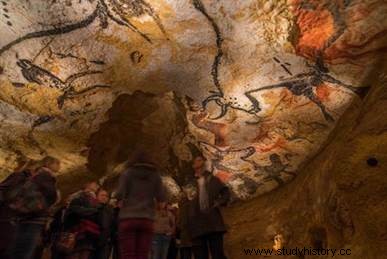 The Lascaux Cave is famous for the masterpieces of Paleolithic art, among the most important ever discovered, which adorn its walls and ceiling. It was discovered in the Dordogne department near Montignac, when four children and a dog entered it for the first time in September 1940. On the walls appear cave paintings of great quality. The walls were admired by many people immediately after the war. Unfortunately, a degradation of the frescoes was caused by intense tourist activity. The room was therefore permanently closed to the public in 1963. Today, it is possible to visit the exact replica of the cave.
The Lascaux Cave is famous for the masterpieces of Paleolithic art, among the most important ever discovered, which adorn its walls and ceiling. It was discovered in the Dordogne department near Montignac, when four children and a dog entered it for the first time in September 1940. On the walls appear cave paintings of great quality. The walls were admired by many people immediately after the war. Unfortunately, a degradation of the frescoes was caused by intense tourist activity. The room was therefore permanently closed to the public in 1963. Today, it is possible to visit the exact replica of the cave.
Discovery and dating of the Lascaux cave
The paintings were in an excellent state of preservation when the cave was discovered on September 12, 1940 by young Montignacois, including Marcel Ravidat and Jacques Marsal. Constant humidity and temperature have provided a favorable environment for the preservation of pigments for thousands of years. The paintings in the Lascaux cave were made during the Upper Palaeolithic, between 17,000 BC. J.-C. and 16000 years BC. AD. dates that are determined, among other things, thanks to the species represented in these places.
Indeed, there is only one reindeer Interpretation observed on the walls. This species disappeared from our regions following a global warming that occurred around 20,000 BC. The other species represented lived in a temperate climate. The Lascaux cave would therefore have been frequented after global warming. Subsequently, the date was clarified by other techniques, in particular that of carbon 14.
The cave extends over a hundred meters. From the main gallery, called the rotunda room or the Hall of the Bulls, appear bison, horses and deer painted in carbon black and yellow or red ink. The colors used are based on mineral oxides from crushed earth and mixed with animal fat. The paint appears to be finger-applied or propelled through a hollow tube, giving the color a hazy appearance. Some paintings reach 5 m in length. At the level of the passage, as well as in the nave, bulls, heifers, ibexes and deer are drawn with less precision. Another peculiarity lies in the presence of a reclining man and injured near a bison. In addition to animals, many geometric signs whose meaning remains unknown are observed.
Painting technique and interpretation
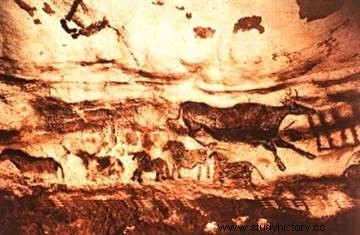
The general interpretation of the Lascaux paintings is debatable. It is possible that they are part of a religious art and that these caves are a sanctuary buried deep in a cave that is difficult to access. Since everything, even the geometric signs, seems to relate to animals, it is thought that this religion would be linked to hunting because, in Lascaux, no element refers to the cult of the dead or that of fertility. This cave would then have been frequented only during periods when hunting was an important issue.
The animal was important in the eyes of men because it is essential to its survival. He may even be feared, which the immense size of some of them would indicate. What is ignored by adopting the religious hypothesis is whether the celebrations took place after the paintings were completed or whether the very act of painting constituted a ritual.
It could also be that these paintings are simply decorative art. In this case, only the formal interest counts and the paintings of Lascaux, of a high artistic level, respond perfectly to this concern. These representations are often overloaded and recall the aesthetics respected in other caves. The art of this period could therefore be dominated by formal conventions.
Lascaux cave:a site in danger
The cave was listed as a historical monument and opened to the public in 1948, but the paintings began to deteriorate, the colors to fade, and a green mold to grow on the pigments. The cave was permanently closed to the public in 1963 by the Minister of Culture André Malraux. The breathing of the million visitors who had already passed through the cave altered his paintings. To date, only researchers, curators and technicians are authorized to access it, at the rate of some 800 human hours per year. and its environment remains tightly controlled.
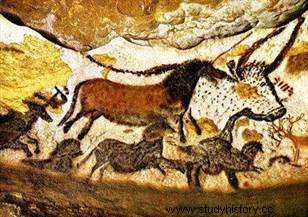 In order for the public to continue to admire the cave, the only alternative was to create a replica. The cave has been meticulously reproduced, where possible, using the same pigments and mixing and application methods that appear to have been employed by the original artists. Lascaux II, as this reconstruction is called, was opened in 1985, and offers nearly 80% of the original frescoes, a few hundred meters from the original site.
In order for the public to continue to admire the cave, the only alternative was to create a replica. The cave has been meticulously reproduced, where possible, using the same pigments and mixing and application methods that appear to have been employed by the original artists. Lascaux II, as this reconstruction is called, was opened in 1985, and offers nearly 80% of the original frescoes, a few hundred meters from the original site.
Since 2000, the international committee for the preservation of Lascaux has pointed out "a series of serious problems which endanger the paintings" of this cave, listed as a World Heritage Site by Unesco, the proliferation of fungi, causing the appearance on the walls of white and black spots. Since then, a scientific council headed by paleoanthropologist Yves Coppens has been responsible for monitoring the health status of Lascaux and organizing research programs to try to understand what is happening in the cave, in terms of climatology and microbiology. This surveillance committee must launch work and study programs to stop and control the biological contamination of Lascaux.
Lascaux 3:traveling exhibition
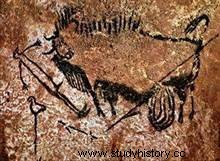 Lascaux 3 is a travelling exhibition which opened its doors in Bordeaux in 2012 before traveling and crossing different continents. The purpose of this traveling exhibition is to show the "Sistine Chapel" of prehistory to all those who cannot travel to the Dordogne and who wish to see the riches of this cave.
Lascaux 3 is a travelling exhibition which opened its doors in Bordeaux in 2012 before traveling and crossing different continents. The purpose of this traveling exhibition is to show the "Sistine Chapel" of prehistory to all those who cannot travel to the Dordogne and who wish to see the riches of this cave.
The 800m² exhibition space is a silent, dark immersion in a nave never reproduced. The walls are reproduced life-size, to the nearest millimeter, on resin shells covered with stones. We find ourselves facing the works as if we were these artists of the past lit by torch or oil lamp. All this thanks to the vibrant lights that reproduce these conditions.
The exhibition also presents the only "man" of Lascaux:the simplified silhouette of a hunter facing a bison which, difficult to access at the bottom of the "Well" of the cave, was seen by very few men. Also reproduced are the so-called "Empreinte" panel and the frieze of ibexes, the Black Cow panel, the panel of Leaning Bisons and the Frieze of Swimming Deer located in the Nave. In addition to the reproduction of frescoes, the he exhibition offers a great deal of interactivity with sensory experiences, a view of the evolving frescoes, their details, and all the iconography of Lascaux, also black and white photos from 1940, models and 3D images of today.
Lascaux IV:International Center for Parietal Art
Built at the bottom of the Lascaux hill, the Centre International de l'Art Pariéta It opens its doors to the public on December 15, 2016 after three years of work and several months of waiting. Not only this new Lascaux 100% reproduces the original cave, thanks to the know-how and techniques of the Atelier des Facsimilés du Périgord, but the Center's project does not stop there... Lascaux 4 reproduces the cave in its entirety, located away from the original site, which we want to preserve from the flow of visitors to Lascaux 2, their cars, their pollution...
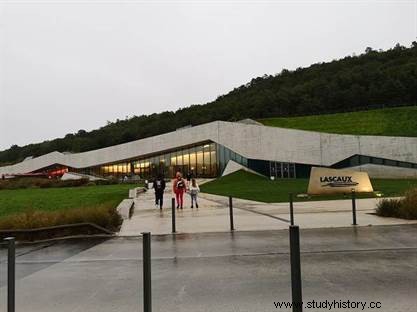 Very modern, the use of new image and virtual technologies in the service of mediation are also at the center of this exceptional visit, from the 3D projection room to the so-called theater rooms, through the interpretation room designed to better understand the works of the cave but also to understand all the historical and cultural issues.
Very modern, the use of new image and virtual technologies in the service of mediation are also at the center of this exceptional visit, from the 3D projection room to the so-called theater rooms, through the interpretation room designed to better understand the works of the cave but also to understand all the historical and cultural issues.
The tour is divided into six sequences:
(1) The Belvedere and the Shelter
(2) The Grotto
(3) The Lascaux Workshop
(4) The Theater of Parietal Art
(5) 3D Cinema
(6) The Imaginary Gallery and the Temporary Exhibition.
The International Center for Parietal Art is the benchmark tourist and cultural facility for showcasing parietal art from the painted and engraved representations located in the Lascaux cave. The Dordogne thus confirms its position as a reference tourist destination in terms of prehistory. The Semitour Périgord, operator of the Centre, includes this project in its prehistoric offer including the facsimile of Lascaux 2, Thot Espace Cro-Magnon and Laugerie Basse.
It is always possible to visit Lascaux II by reservation. More intimate and less "techno", this route will allow you to immerse yourself in a more realistic way in the atmosphere of the visit to the cave.
To go further
- Lascaux, stories of a discovery, by Christian Jégou and Marylène Patou-Mathis. West-France, 2019.
- Lascaux, the Discovery of the Cave, by Emily Arnold Mccully. Archimedes, 2011.
- All Lascaux, by Pedro Lima and Yves Coppens. Synops, 2017.
